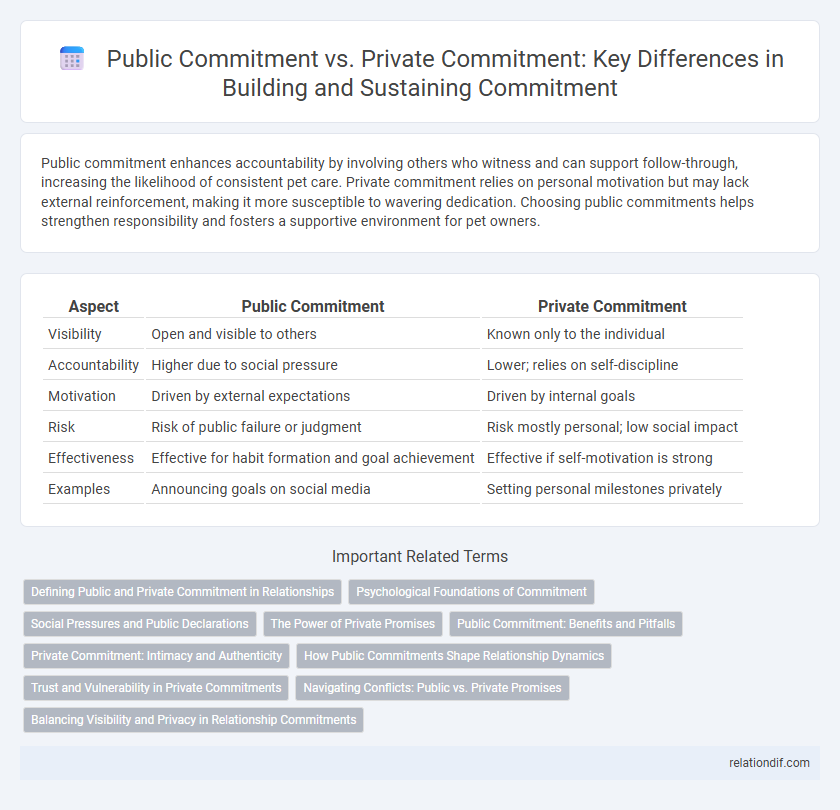Public commitment enhances accountability by involving others who witness and can support follow-through, increasing the likelihood of consistent pet care. Private commitment relies on personal motivation but may lack external reinforcement, making it more susceptible to wavering dedication. Choosing public commitments helps strengthen responsibility and fosters a supportive environment for pet owners.
Table of Comparison
| Aspect | Public Commitment | Private Commitment |
|---|---|---|
| Visibility | Open and visible to others | Known only to the individual |
| Accountability | Higher due to social pressure | Lower; relies on self-discipline |
| Motivation | Driven by external expectations | Driven by internal goals |
| Risk | Risk of public failure or judgment | Risk mostly personal; low social impact |
| Effectiveness | Effective for habit formation and goal achievement | Effective if self-motivation is strong |
| Examples | Announcing goals on social media | Setting personal milestones privately |
Defining Public and Private Commitment in Relationships
Public commitment in relationships involves openly expressing dedication to a partner through social channels such as social media announcements, shared events, or formal declarations, reinforcing accountability and social recognition. Private commitment remains an internal, personal vow or emotional attachment, often communicated discreetly between partners, emphasizing trust and intimacy without external validation. These differing modes of commitment shape relationship dynamics by balancing public accountability with private emotional security.
Psychological Foundations of Commitment
Public commitment triggers social accountability mechanisms that enhance motivation by aligning individual behavior with perceived group expectations, leveraging the psychological principle of consistency. Private commitment, rooted in intrinsic motivation and internalized values, engages self-regulation processes that sustain persistence even without external observation. The interplay of social identity theory and cognitive dissonance explains why publicly stated commitments often generate stronger adherence compared to privately held intentions.
Social Pressures and Public Declarations
Public commitment leverages social pressures by making declarations visible to others, increasing accountability and motivation to follow through on goals. Private commitment lacks this external visibility, relying primarily on internal motivation, which can be less effective for behavior change. Public declarations enhance commitment strength by engaging social norms and expectations, creating a sense of obligation through community observation.
The Power of Private Promises
Private commitment harnesses the deep psychological impact of personal promises, creating intrinsic motivation that often surpasses the influence of public declarations. Research shows that privately made commitments engage self-concept and internal accountability, leading to more consistent and genuine follow-through. This subtle form of dedication reduces social pressure and external judgment, fostering a resilient, self-driven pursuit of goals.
Public Commitment: Benefits and Pitfalls
Public commitment significantly increases accountability by leveraging social pressure, which boosts motivation and follow-through in achieving goals. However, it also carries the risk of failure being more visible, potentially leading to embarrassment or loss of credibility. Carefully balancing transparency with realistic expectations can maximize the benefits while mitigating the pitfalls of public commitment.
Private Commitment: Intimacy and Authenticity
Private commitment fosters deep intimacy and authenticity by allowing individuals to express their true selves without external judgment. This type of commitment encourages trust and emotional vulnerability, strengthening relational bonds through genuine connection. By prioritizing personal values and mutual understanding, private commitment builds a resilient foundation for long-term relationships.
How Public Commitments Shape Relationship Dynamics
Public commitments create a stronger sense of accountability by increasing social pressure, which often leads to higher follow-through rates in relationships. When individuals make promises openly, they signal trustworthiness and reliability, reinforcing the bond between partners. This dynamic fosters greater transparency and mutual expectations, ultimately enhancing relationship stability and satisfaction.
Trust and Vulnerability in Private Commitments
Private commitments foster deeper trust by allowing individuals to express vulnerability without fear of judgment or external pressure, strengthening the emotional bond. Unlike public commitments, which can provoke performative behavior to maintain social image, private commitments emphasize authenticity and mutual understanding. This environment of trust encourages open communication, reinforcing the reliability and resilience of the commitment over time.
Navigating Conflicts: Public vs. Private Promises
Public commitment involves openly declaring intentions, increasing social accountability and pressure to follow through, which can strengthen motivation but also heighten conflict if priorities shift. Private commitment allows for more personal reflection and flexibility, reducing external pressure but potentially decreasing accountability. Navigating conflicts between public promises and private intentions requires balancing transparency with adaptability to maintain trust and integrity.
Balancing Visibility and Privacy in Relationship Commitments
Balancing visibility and privacy in relationship commitments involves managing public displays and private understandings to strengthen trust and accountability. Public commitments, such as social media declarations or engagement announcements, increase relational accountability and social support but may introduce pressure or scrutiny. Private commitments foster intimate communication and emotional security, allowing couples to build a foundation free from external judgment while maintaining personal boundaries.
public commitment vs private commitment Infographic

 relationdif.com
relationdif.com